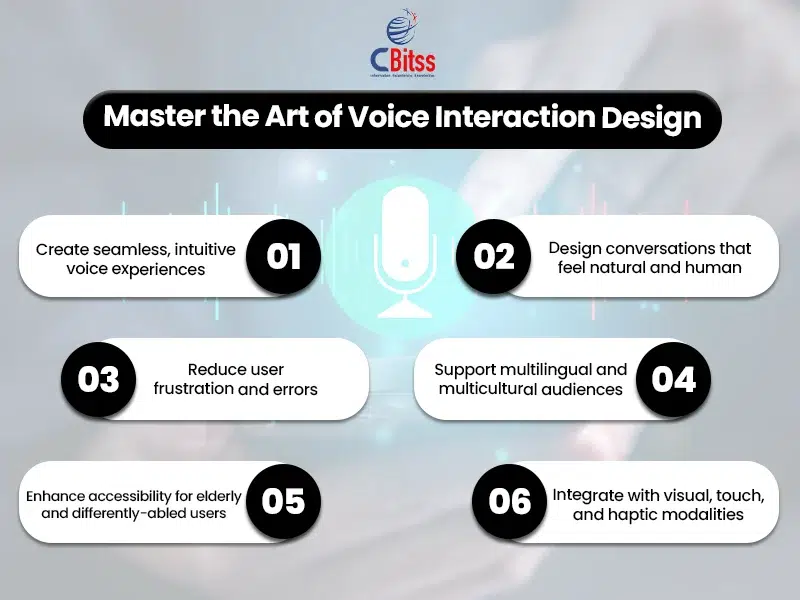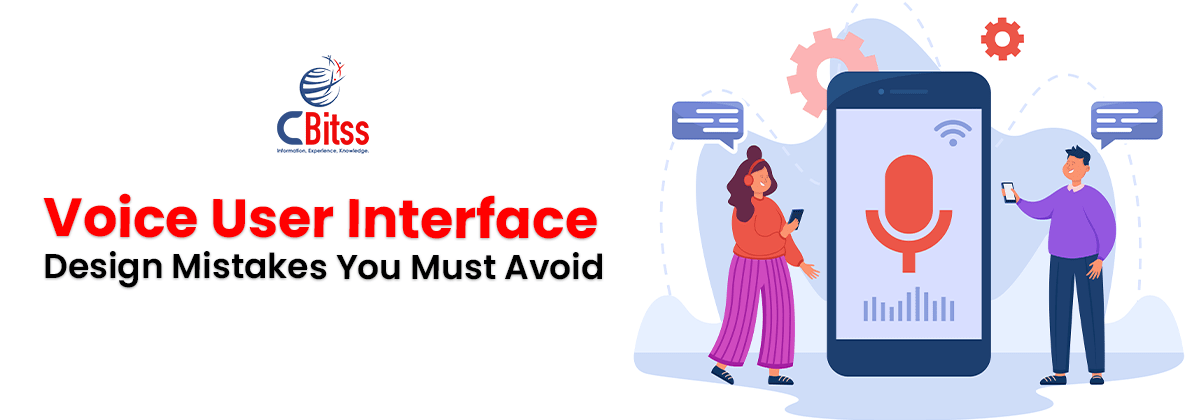Table of Contents
ToggleIntroduction
Voice User Interface Design Mistakes You Must Avoid is an essential source of information to all people in the sphere of conversational experiences. With voice-enabling devices and assistants everywhere, it is important to know how to design a voice user interface that works in the most efficient way. Inappropriate design may result in frustration, less engagement among users, and finally, the failure of the application. In this article, you can discover the most frequent traps and offer practical details to design efficient and user-friendly voice interfaces.
This article will introduce you to the pitfalls of voice UI design and how to design voice user interfaces. Also, you will find out what strategies can be implemented in practice to prevent these pitfalls. At the end, you will be in a position to build voice experiences that are logical, smooth, and pleasant to the users.
Understanding Voice User Interfaces
Voice UIs enable the user to communicate with the device in a voice rather than a text or touch interface. There is a need to learn how to design a voice user interface because effective voice interface design will make conversations fluid and pleasant, and will reduce the cognitive load. In the absence of these factors, users might have miscommunication, mistakes, or frustration.
This is because the basics of learning provide the foundation for the development of effective voice experiences.
For those curious about how AI differs from generative AI, this knowledge can help understand adaptive interfaces.
Context, tone, and intent of the users are also significant considerations in designing voice user interfaces PDF so that it can respond accurately. Feedback should be consistent, and there must be demonstrations on how to use the system to interact with it properly. Besides, the use of real-user testing will be necessary to determine pain points and optimize the experience to create a natural, unhindered communication.
Exploring AI apps can help designers test voice interactions effectively.

Voice User Interface Design Mistakes You Must Avoid
- Giving excessively lengthy responses to users.
- Constant use of technical jargon or very complicated language.
- Lack of regard for the context or environment of the user.
- Creation of unnatural or hard-to-remember commands.
- Not being able to give confirmations or feedback.
- Failure to consider access by various users.
Designing for Multilingual and Multicultural Audiences
It is important to develop voice interfaces to support linguistic and cultural diversity. Cultural norms, dialects, and expressions require designers to consider them to ensure inclusive interactions.
Also, it is worth noting that there are great differences in language structures among different cultures. This is when how to design a voice user interface comes into effect. As an example, phrases in the German language may take more time compared to English, which may influence prompt and response design. The success of adapting these differences will make the voice interface friendly and natural to all languages.
For insights on future computing, see quantum computing and its applications.
Balancing Personality and Professionalism in Voice Assistants
- Develop a friendly but professional voice persona.
- Do not be too casual and make statements less credible.
- Be consistent in the reactions to the tasks.
- Align tone with customer situation and brand image.
- Do not be too funny or too much of a personality.
Understanding AI in web design can guide tone and style choices.
Redefine user experience with intuitive and responsive voice-driven design systems today.
Implementing Context-Aware Responses in Voice Interactions
Voice interface design provides a personalized response, which is provided by context-awareness. To enhance the quality of interaction, designers ought to have in mind the user’s history, location, and the tasks at hand. An assistant with contextual awareness will be able to predict demands and reduce redundant requests, and provide a natural conversation.
In addition, the voice interface can be designed to respond to divergent user situations by the addition of situational awareness. As an example, usability and user satisfaction may be improved by changing the verbosity of the responses depending on the environment of a user (i.e., use shorter prompts in noisy places).
Learning about prompt engineering can improve context-aware response design.
Designing for Voice Interfaces in Noisy Environments
- Speech recognition optimization to ambient noise.
- Supporting fallback, such as touch or visual.
- Prove voice communication in the noisy real world.
- Use short commands to ensure reduced recognition errors.
- Add restatements, explanations where necessary.
- Adapt the response time to compensate for the misheard commands or slow commands in noisy conditions.
- Install noise-adjusting programs that remove the background noise and trace the voice of the user.
- Take advantage of the environmental contextual clues (e.g., location or activity) to enhance response accuracy and relevance.
Using trending AI tools can help improve recognition in noisy environments.
Ethical Considerations in Voice Data Collection and Usage
In the same way, the voice data collection is a matter of privacy. Informed consent, transparency, and safe storage are the most crucial aspects that the designers should focus on to preserve the trust of users.
One should also ensure that there is a reduction in the amount of data that is to be used in data collection to the level that is actually required to work with the application. User privacy is also enhanced by anonymizing the data wherever feasible. Also, it is important to share the information on how the data is used and to explicitly request the consent of the users to encourage trust and adhere to legal and ethical requirements.
For guidance on AI’s role in marketing jobs, ethical considerations are key.
Integrating Voice Interfaces with Other Modalities
Integrate voice and visual or touch or haptic.
Provide the users with the freedom to select the means of interaction.
Multimodal interfaces increase the usability and accessibility.
Use similar patterns of design across modalities.
Combined modalities in the test should be avoided to avoid confusion or redundancy.
Studying AI in modern web design can help coordinate modalities effectively.
Empower your apps through advanced voice user interface design built for performance.
Designing for Voice Interfaces in Healthcare Applications
Voice interface design can enhance hands-free functionality within the healthcare industry, enhancing efficiency as well as hygiene. Medical terminologies, critical response times, and levels of stress to be used by the user are some of the factors that designers need to consider.
Moreover, it is important to take into account the emotional condition of patients. Moreover, a gentle and compassionate voice reduces patient anxiety and enhances their overall experience. Further, the voice interface must address such nuances to ensure effectiveness in a healthcare environment.
Understanding AI vs human intelligence is useful in sensitive environments like healthcare.
Optimizing Voice Interfaces for Elderly Users
The voice interface used by older adults should include addressing hearing difficulties, mental load, and familiarity with technology. Accessibility is enhanced by the use of simple commands, slower speech, and clear prompts.
Moreover, it is possible to add such features as increased font size, variable speech rates, and voice feedback, which can greatly contribute to making this system easier to use by seniors. It also helps that there should be some choices on how to set a setting for the users so that interaction could be more individual and comfortable.
Exploring types of machine learning can provide insights for elderly-friendly design.
Future Trends in Voice User Interface Design
- Personalized with AI: Therefore, AI improves personal response habits and creates smoother communication for individuals.
- Learn more about generative AI vs AI.
- IoT Support and Smart Home Ecosystems: Moreover, users actively control connected devices through voice interfaces to achieve effective home automation.
- Emotion Detection and Empathetic Assistants: Assistants identify emotions and respond in an empathetic manner to act as a human being.
- Reading about AI prompt engineering can improve this capability.
- Multimodal Interaction: Additionally, users interact with the system actively using voice, visual inputs, and touchpoints for smooth accessibility.
- The continuing Learning through Interaction with the user: Assistants learn as the user interacts with them, based on the behaviors of the user and feedback.
- Enhancing digital marketing skills can guide adaptive learning approaches.

Conclusion
Finally, to learn voice UI design, you should be aware of the Voice User Interface Design Mistakes You Must Avoid and how to design voice user interfaces. Moreover, designers employ clarity, context-awareness, inclusivity, and ethics to create smooth conversational interactions.
Train designing voice user interfaces PDF, and practical materials. Further, test your designs in the real world, improve them based on the feedback, and create voice experiences that will be delightful to users.
Understanding PPC in digital marketing can inform how user data is used responsibly.
Start learning voice user interface design mistakes you must avoid today to create intelligent, user-friendly, and future-ready voice interfaces. Enroll in our program to learn how to design voice user interfaces. Master the art of designing next-generation voice interactions.
See trending AI tools to enhance your learning further.

J. Julia Kamei is a professional content writer with 4+ years’ experience creating impactful content for clients in the USA, India, Canada, the UK, and Europe. An M.A. History graduate, she specializes in immigration, business, IT, digital marketing, AI, and Data Science. She also mentors students for international education and research.







